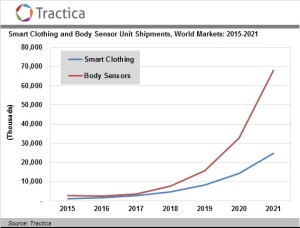 The market research company Tractica says consumers will buy as many as 190 million pieces of what it categorizes as smart clothing and body sensors in the next five years. But they don’t really say how that might happen.
The market research company Tractica says consumers will buy as many as 190 million pieces of what it categorizes as smart clothing and body sensors in the next five years. But they don’t really say how that might happen.
If you want detailed numbers, you’ll have to pony up $3800 for the full report. (We’re generally pretty skeptical of five-year market projections, which is why we don’t do them.) But an executive summary, for which you may have to register, indicates that both markets are pretty small today: deep into the low millions. It’s not until 2018 that they predict a market inflection point. Even by 2021, they predict that smart clothing will be more than two-thirds of the market, at about 60 million devices.
Tractica defines “body sensors” as things like heart-rate straps, posture monitors, EEG monitors/meditation aids, pregnancy aids, wearable patches, and so on. It pegs most of the activity as coming from the medical market unless someone comes up with a consumer use case. Possible drags on the market, it says, are the lack of a high-profile product champion (think Apple with smartphones) and the possibility that no one will be able to figure out what any of this stuff is good for.
What’s new about the Tractica report is the number. There’s a considerable about of “this is where we are, and the magic happens” about the analysis, in that it relies on product, marketing, and technological advances that the company does not specify. None of those are new to regular readers.